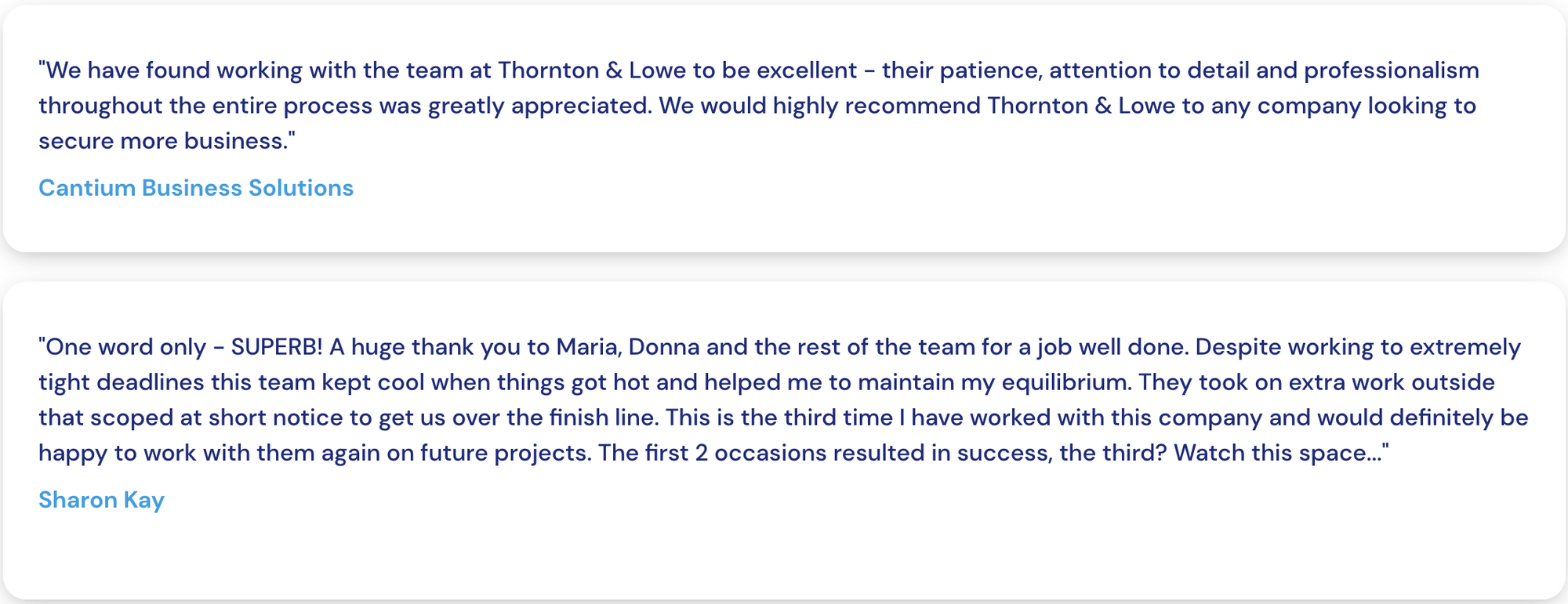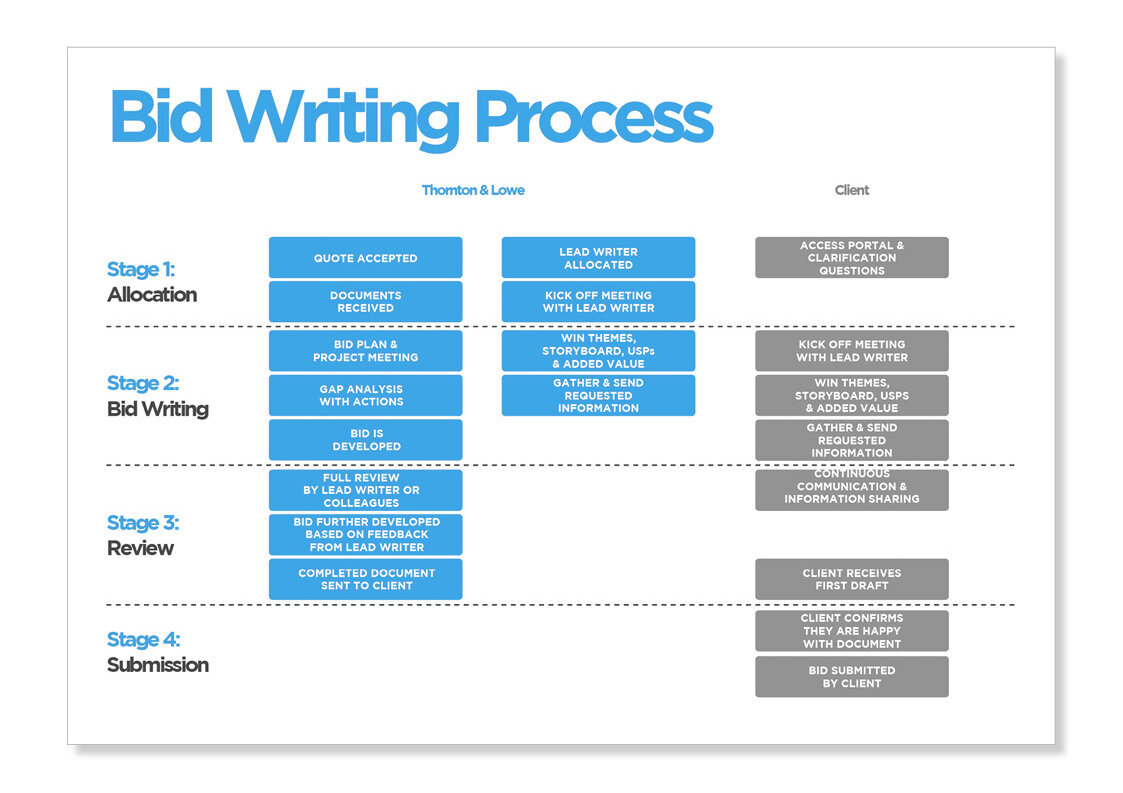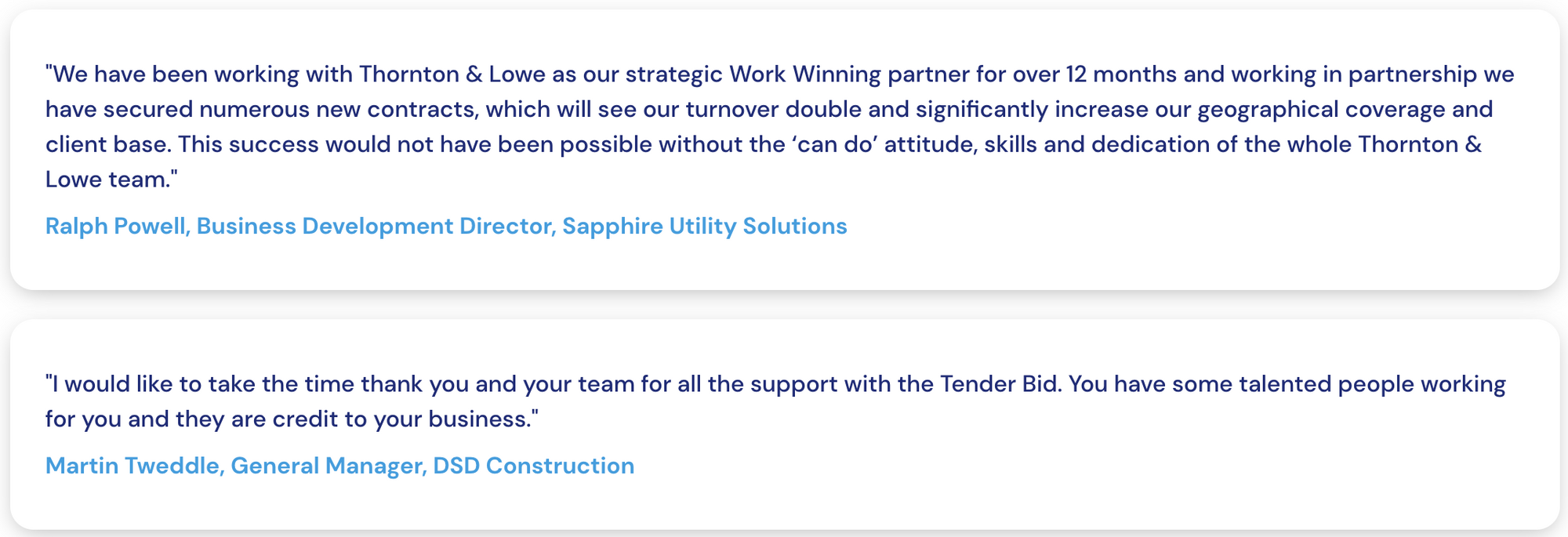Trying to understand how tendering works so you can start winning contracts with confidence? This step-by-step guide explains each stage in plain English, from deciding whether to bid through to submission and award. You’ll learn what buyers expect, how to avoid common pitfalls, and the practical actions that improve scores.
The Tendering Process
In this article we will provide clear guidance on what the tendering process is, the steps involved and some best practice for those looking to be involved - whether as a supplier or a buyer.
Cambridge Dictionary describes tendering as:
"the process of choosing the best or cheapest company to supply goods or do a job by asking several companies to make offers for supplying the goods or doing the work:The whole process is done by competitive tendering.The laundry contract was awarded to the company that had offered the lowest price in the tendering process."
This definition is focused on the perspective of the buyer managing the tendering process. The 'companies' making the offers, who put forward bids, proposals and tender responses are often called tenderers.
From a suppliers perspective, the tendering process is often the key route for businesses looking to win longer term contracts with larger organisations, whether in the public or private sector. Due to the length and value of the commitment given to suppliers - a buyer wants to ensure they get the best deal (which includes quality and price).
If you are learning about the tendering process - you will also need to understand the term 'procurement'. Again, the Cambridge Dictionary describes it as "the process of getting supplies." It is the purchasing - or the wider process of buying good and services, which often involves strategy as well as the more administrative elements of the actual purchase itself.
A buying or procurement team will manage the tendering process. The suppliers or tenderers will compete to win work!

Understanding the Tender Lifecycle
Due to the values involved - tendering best practices, set stages and rules have been developed. As a company/ supplier or bidder you will need to understand both procurement and bid management to really excel. From the EOI (Expression of Interest), PQQ (Pre-Qualification Questionnaires), through to the invitation to tender (ITT). It's become an industry of all of its own!
Many SME's use a professional bid writer to manage the entire process for them. Read a quick summary here to learn what a bid writer is and what they can do for your business.
The tendering process is best described as a lifecycle or journey - purely focused on ensuring that the procurement is competitive, transparent, and yields the best value for both the buyer and the supplier. These stages are detailed below - however, you still need to remember the overarching aims of the tendering process, which are super simple. A business or organisation or individual wants or needs something. They invite some interested likely suppliers to get involved. Or for example, you need a new roof for your house. You google local roofers or find a trade magazine. You ask them to take a look, explain what you need and ask for a quote. This is the tendering process - but just a little less formal than what we typically see in business!
Initial Planning
The procurement journey begins with the initial planning stage, where buyers identify their needs through market research and analysis of current market conditions, often called preliminary market engagement (PME). This stage involves determining the procurement strategy, levels of competition and risk, and tailoring the tender documents as a result.
Bid Document Production
Following the planning, we move to the document production stage. Here, contracting authorities or public sector buyers, for example, create tender documents, such as the Request for Proposal (RFP) or Invitation to Tender (ITT). These documents are critical as they outline buyer requirements, the scope of work, and the criteria for evaluation. Ensuring these documents are detailed and clear is key to attracting the right suppliers and facilitating a fair bidding process.
Tender Submission Phase
During the submission phase, potential suppliers submit their bids in response to the tender documents. This phase is crucial as it marks the point where we begin to see the potential partners' proposals and their understanding of the project requirements. This tender response or bid writing stage is often the biggest challenge for many of our clients.
Evaluation Phase
Next, we enter the evaluation phase, where your bid is assessed in order to find the most suitable supplier. From a procurement perspective this approach is very important as they need to ensure all bids are evaluated fairly and transparently. Within public sector or government tenders, they will often use a balanced evaluation team, comprising financial, technical, and procurement experts, to review each submission against the set criteria without bias.
Post-Evaluation Phase
Finally, the post-evaluation phase involves finalising the contract with the selected supplier - finding out if you have been successful. This stage is not just about a contract award and signing a contract but also about setting the foundation for a successful partnership. It includes managing the contract effectively and possibly reviewing the entire tender process to refine future procurements. As the buyer reviews their process, the bidders or suppliers will be looking to see how they can bid more efficiently and effectively on the next opportunity.

Need tendering support?
Contact us
How Thornton & Lowe Can Support Your Tendering Success
At Thornton & Lowe, we help businesses navigate the tendering process with expert support at every stage. Our team ensures you have the best chance of success with:
- Bid & Tender Writing – Clear, compelling, and compliant bid submissions tailored to each opportunity.
- Procurement Guidance – Expert advice on regulations, procurement strategy, and how to identify the right tenders.
- Consultancy Services – Practical support with bid management, competitor insights, and tendering best practices.
- Training & Development – Hands-on training to help your team improve bid writing skills and win more contracts.
Whether you’re new to tendering or looking to improve your success rate, Thornton & Lowe provides the expertise and practical support to help you secure contracts.

Key Documents in the Tender Process: Once Shortlisted
We know the tendering process is complex, so we need to ensure we can work within it efficiently. This means really looking at the structure and requirements for each of the key tender stages our business will encounter, and developing solutions for them. These 'requirements' are often the tender documents. These documents form the backbone of any tender process, guiding both the buyer and the supplier through pre-qualification to the final agreement.
Request for Proposal (RFP)
An RFP is a comprehensive document that announces a project, outlines its scope, and requests bids from qualified contractors to complete it. It details the project requirements, evaluation criteria, and instructions for submitting proposals. This document is crucial as it sets the stage for what the buyer expects and how bidders should format their responses. The RFP process is transparent, allowing for a fair comparison of bids based on predefined criteria.
In the UK public sector often the term RFP is used interchangeably with ITT.
Invitation to Tender (ITT)
Following the PQQ or SW (detailed below), shortlisted candidates receive an ITT, which invites them to submit a detailed tender proposal. This document specifies the tendering process, submission guidelines, and the scope of work. The ITT can be open, inviting all qualified bidders, or closed, limited only to those pre-selected or shortlisted. This document is pivotal as it provides detailed information on what the buyer needs, allowing suppliers to tailor their proposals accordingly.
Contract Agreement
The final stage in the tender process is the signing of the contract agreement. This document outlines the terms and conditions of the contract, the obligations of both parties, timelines, and the standards expected. It also includes details on monitoring and evaluating the supplier’s performance throughout the contract period, ensuring compliance and fulfilment of contract terms.
Understanding these documents is essential for any supplier wishing to participate in the tendering process. Each document serves a specific purpose, guiding the supplier from initial inquiry through to final selection, ensuring a clear, fair, and efficient procurement process.

Selection Questionnaire (SQ), PQQ and Shortlisting Bidders
Often before a tender, ITT or RFP can be evaluated a business needs to be shortlisted. Quite often this pre-qualification or selection stage is completed at the same time. Therefore making sure you can pass the SQ is very important. Failing this you complete a full tender response and pricing with the risk of this not even being evaluated.
The Selection Questionnaire (SQ) is a key initial screening tool used in the tendering process to evaluate potential bidders. It assesses the suitability, financial stability, capability, and relevant experience of companies interested in bidding for a contract. This step is essential for shortlisting competent bidders who are best equipped to meet the contract requirements effectively and efficiently.
Key Components of the Selection Questionnaire:
Financial Stability
- Financial Health: Questions about the company’s financial statements, including balance sheets, profit and loss accounts, and cash flow statements.
- Credit Ratings: Information about the company’s creditworthiness and financial reliability.
- Financial Ratios: Assessment of key financial ratios such as liquidity ratios, debt-to-equity ratios, and profitability ratios.
Capability and Experience
- Technical Skills: Queries regarding the technical skills and qualifications of the company and its key personnel.
- Relevant Experience: Evidence of past projects similar in scope and complexity, including case studies, references, and client testimonials.
- Resources and Equipment: Details about the company’s resources, equipment, and technological capabilities required for the project.
Compliance and Legal Information
- Legal Compliance: Questions related to the company’s compliance with relevant laws and regulations. When tendering compliance and ensuring clear company policies is highly important.
- Accreditations and Certifications: Information on industry-specific accreditations, certifications, and quality standards the company adheres to.
- Insurance Coverage: Evidence of appropriate insurance coverage, such as liability insurance and professional indemnity insurance.
Health and Safety
- Safety Records: Information on the company’s health and safety records, including any past incidents or violations.
- Safety Policies: Details about the company’s policies and procedures, demonstrating a commitment to maintaining a safe working environment.
Environmental, Social Responsibility & Social Value
- Sustainability Practices: Questions about the company’s environmental policies and sustainability practices.
- Corporate Social Responsibility (CSR): Information on CSR initiatives and the company’s commitment to ethical business practices and community engagement.
- Social Value: An increasing area of importance when tendering, being able to respond to social value questions, commitments and reporting requirements is now critical. These scored sections of the tender response will only increase as a result of the Procurement Act.
References and Performance History
- Client References: Contact details of previous clients who can vouch for the company’s performance and reliability.
- Performance Metrics: Data on past project performance, including timeliness, budget adherence, and quality of work delivered.
Pre-Qualification Questionnaire (PQQ)
The PQQ is still used, however, the SQ has taken over as the required shortlisted mechanism required by public sector bodies. Like the SQ, it assesses a company's financial stability, capability, and experience in relation to the project at hand. The PQQ will include questions about financial health, technical skills, and other relevant company information, ensuring that only the most suitable candidates proceed to the bidding stage.
It is often called Open Tendering, when a PQQ or SQ is not used.

Evaluating Tender Opportunities
As a supplier or bidder, understanding how your bid will be evaluated can really help you understand your likely chances of success and how to improve your approach to tendering. However, we can you can do this you need to understand if is the right opportunity to bid for. You need to understand what questions to ask before writing a tender response. This involves research and preparing. This is often called a bid-no-bid decision or bid qualification, which forms part of a bidding master plan. In the sector below we focus on this exclusively, however, below we cover wider research requirements.
Public vs. Private Sector
Public sector tenders are heavily regulated, often requiring adherence to the Public Contracts Regulations (PCR), soon to be the Procurement Act. Prior to this and still across Europe, Official Journal of the European Union (OJEU) rules had to be followed. These tenders are typically more transparent and structured, with defined stages such as Expression of Interest (EOI), Pre-qualification Questionnaire (PQQ), and Invitation to Tender (ITT). In contrast, private sector tenders may not follow a standardised process and are less likely to be publicly advertised, relying more on direct negotiations with known suppliers. Understanding these differences is vital for tailoring our approach to each sector effectively.
We are seeing more private sector tenders follow the approach and principles of pubic sector procurement, which increases the accountability and ethics of an organisation.
Understanding Buyer Requirements
Understanding the buyer's requirements goes beyond reviewing the tender documents; it involves getting into the buyer's shoes, understanding their challenges, their organisational ethos, current market position, and future needs. By analysing tender documents and the buyer's digital footprint, including websites and social media, you can gain insights into their core values and can align our tender submissions accordingly. This alignment is not just about meeting the specifications but also about demonstrating how your offerings can add value to the buyer's operations and help them achieve their strategic goals.
Market Research
Market research is so important in the tendering process. It provides us with a clear understanding of market trends, competitor analysis, pricing strategies, and customer preferences. This information is crucial for crafting a competitive yet realistic tender submission. By identifying the strengths and weaknesses of potential competitors, we can better position our proposal. Additionally, staying updated on regulatory changes and technological advancements ensures that our tender is not only compliant but also innovative.
By meticulously evaluating each tender opportunity through these lenses, we enhance our chances of not only winning the tender but also establishing a long-term partnership with the buyer, ultimately leading to mutual growth and success.
Looking to outsource your tendering?
Contact us todayBid/No-Bid Assessment: Key Questions and Areas to Consider
When evaluating whether to pursue a new tender, you need to conduct a thorough Bid/No-Bid assessment. This process helps to determine if the opportunity aligns with your company’s strategic goals and capabilities. Here are key questions and areas to consider:
Strategic Alignment
- Does the tender align with our company's strategic goals and objectives?
- Will winning this tender enhance our market position or open new opportunities?
- Is this tender in line with our core competencies and strengths?
Client Relationship
- Do we have an existing relationship with the client?
- Do we understand the client's needs and expectations?
- What is our past experience with this client or similar clients?
Competitive Landscape
- Who are the likely competitors, and what are their strengths and weaknesses?
- Do we have a competitive advantage in terms of price, quality, or innovation?
- What is our win probability based on previous bids and market intelligence?
Financial Considerations
- What is the estimated cost to prepare and submit the bid?
- What are the potential financial risks and rewards?
- Can we deliver the project within the budget and still make a profit?
Resource Availability
- Do we have the necessary resources (staff, equipment, technology) to deliver the project?
- Will this tender overextend our current resources and affect other projects?
- Are the required resources available within the project timeline?
Technical Requirements
- Do we meet all the technical requirements and specifications of the tender?
- Do we have the capability to deliver innovative solutions that meet or exceed the client’s expectations?
- Are there any technical challenges or risks that could impact project delivery?
Risk Assessment
- What are the major risks associated with this tender, and can we mitigate them?
- Is the client known for fair and prompt payments?
- Are there any legal, regulatory, or compliance issues to consider?
Project Scope and Timeline
- Is the project scope clear and well-defined?
- Can we realistically meet the project deadlines?
- Do we have a clear plan for project execution and delivery?
Bid Team Capability
- Do we have a dedicated and experienced bid team to prepare a competitive bid?
- Is the team familiar with the client's industry and specific requirements?
- Do we have a strong proposal manager to oversee the bid process?
Tendering & Bid Writing Process with Thornton & Lowe

Achieving Tendering Success
Developing a Strategy
By understanding what you want to bid for, where you know you stand a good chance of winning and having efficient systems to respond, you have perfect building blocks for tendering success. This supported by a seamless tendering workflow from qualification to project mobilisation, ensuring that every team member has easy access to essential information and documentation, then you really are winning! This eliminates unnecessary delays and allows actions to be instigated quickly. By adopting a comprehensive bid project plan, you can effectively manage resources, activities, timelines, and deliverables. Regular meetings, progress reports, and documentation of decisions are crucial to keep all parties informed, aligned, and engaged throughout the project lifecycle.
Past Experience and Evidence
We cannot stress enough the importance of evidence and past experience when it comes to tendering. This is an important element of bid qualification, but once you have decided to bid, it is then essential throughout your submission. Within the ITT documentation and instructions to bidders it also makes this pretty clear. For example the marking scheme, will often note that in order to score the highest points in each quality question, you need to provide "full assurance, low risk and confidence" in the delivery. This is achieved with evidence, case studies, statistics, testimonials and KPIs, as well as highlighting your expertise and understanding of their needs. This further demonstrates your experience as you are able to highlight the challenges associated with the delivery of the contract, alongside how you will mitigate these better than other bidders.
This bid strategy not only reassures buyers of your competence but also significantly enhances your credibility in the tendering process.
Continuous Improvement
Adopting continuous improvement strategies is fundamental to successful tendering. You will need to regularly evaluate and refine your processes to adapt to changing market conditions and regulatory landscapes. This involves leveraging technology and automation to enhance the speed, accuracy, and efficiency, for example. By developing a culture that embraces change and continuous learning, we ensure that your team remains adaptable and motivated.
Prefer to discuss the tendering process?
Speak to usUnderstanding Scoring Methodology of Tendering to Win More
Bid management and tendering process go together hand-in-hand. Bid management is all about winning contracts and tenders and extends beyond bid writing to include the whole work winning process.
An understanding of the buyer's scoring methodology really helps when developing a work winning bid strategy or simply responding to a tender. Buyers use scoring systems to objectively evaluate bids against predefined criteria. Knowing what criteria will be scored and how points are allocated allows bidders to focus their efforts for maximum impact.
Common scored sections include quality responses about service delivery, mobilisation, risk management and added value. Social value and price are also increasingly prominent. The key is understanding the relative weighting between sections to prioritise your efforts.
Once you know the scoring methodology, you can implement targeted work winning strategies:
- "Bid/No Bid" decisions - Only pursue opportunities you have a good chance of winning based on the scoring criteria. Play to your strengths and walk away from unsuitable bids.
- Storyboarding and planning - Map out your key win themes, discriminators and proofs aligned to the scoring sections.
- Focussed reviews - Evaluate your draft responses objectively against the scoring criteria. Have you maximised every available point? Collaborate with subject matter experts to enhance your submission.
- Compelling value propositions - Clearly articulate your added value in a way that addresses the buyer's key business outcomes and priorities. Provide tangible evidence.
- The importance of price - Ensure your quality score is high enough that you can still win with a carefully judged price. Don't leave money on the table unnecessarily.
- Capturing buyer intelligence - Build relationships with key decision makers to understand their needs, challenges, and preferences. This insight can inform your bidding strategy.
- Bid leadership - Assign a senior sponsor to oversee the bid process, make timely decisions, and ensure the necessary resources are in place.

Tender Process FAQ
What exactly is a tender?
A tender is an official invitation from an organisation requesting suppliers to submit proposals or bids to provide goods, services, or works. It is a competitive process where the best bid, based on price, quality, and other specific criteria, is awarded the contract.
Who issues tenders?
Tenders are typically issued by public sector organisations such as local councils, government departments, NHS trusts, educational institutions, and housing associations. Private sector organisations also regularly issue tenders to procure services or products.
What are the main stages in the tender process?
The main stages typically include identifying tender opportunities, expressing interest, pre-qualification or selection questionnaires, receiving tender documents, writing and submitting a bid, evaluation by the buyer, clarification meetings (if applicable), and finally, contract award.
How do I find tender opportunities?
Tender opportunities can be found on dedicated tender portals such as Contracts Finder, TED (Tenders Electronic Daily), or sector-specific sites. Registering with procurement portals and subscribing to alerts tailored to your business sector and geographic region is advisable. Tender Pipeline is our free service which collates all of these daily.
What is a Pre-Qualification Questionnaire (PQQ)?
A Pre-Qualification Questionnaire is a document issued to shortlist suitable suppliers before inviting them to submit full tender responses. It typically assesses factors such as financial stability, previous experience, quality assurance, and compliance with regulatory requirements.
What makes a strong tender response?
A strong tender response clearly addresses each question, demonstrates a thorough understanding of the client's needs, provides evidence-based answers highlighting relevant experience, outlines clear benefits, and meets all specified submission criteria, deadlines, and format instructions.
Can small businesses win tenders?
Absolutely. Many tenders actively encourage submissions from SMEs (small and medium-sized enterprises). Small businesses often offer competitive advantages such as flexibility, innovation, and local knowledge, all of which can be compelling factors for awarding contracts.
What should I do if my tender is unsuccessful?
If your tender is unsuccessful, always request feedback. Understanding why your bid was not selected will help improve future submissions. Analyse feedback, refine your approach, enhance your tender library, and consider training or consultancy support to improve your tendering skills.





